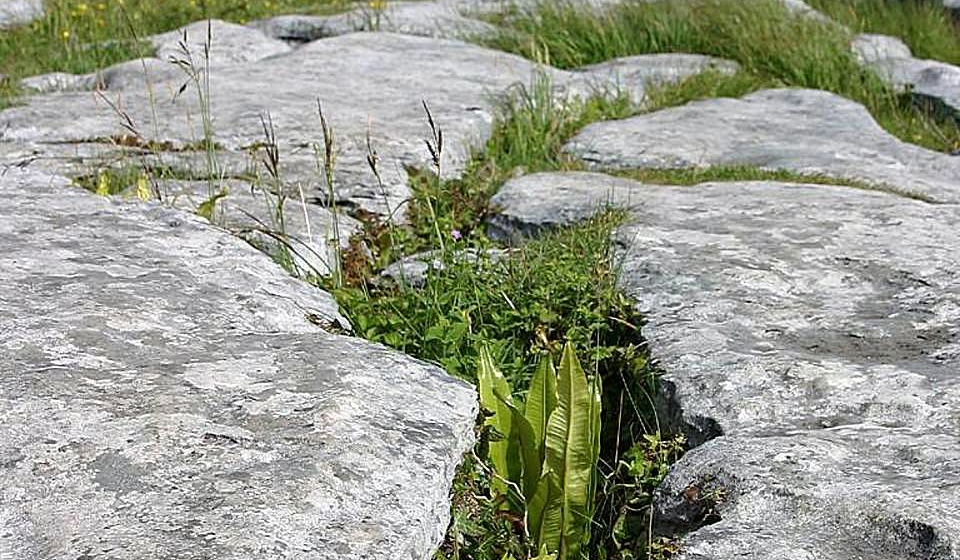Featuring image: Plants slowly eroding limestone. Picture from Jon Sullivan, public domain (C0).
Paper: Composition of continental crust altered by the emergence of land plants
Authors: C. J. Spencer, N. S. Davies, T. M. Gernon, X. Wang, W. J. McMahon, T. R. I. Morrell, T. Hincks, P. K. Pufahl, A. Brasier, M. Seraine and G.-M. Lu
In the winter of 1990, the first Voyager spacecraft looked over its shoulder and snapped an iconic photo of Earth as a ‘pale blue dot’ in the vast cosmos. But when you look at it from Space, there is another very important colour: green. Plants cover a major portion of the landmasses. Besides bringing their bright chlorophyll colour to the continents, new research by Spencer and co-authors finds that plants have also slowly changed the composition of the Earth’s crust over hundreds of millions of years.
In a recent study, Spencer and co-workers were able to connect the development of land plants to changes in the geochemical composition of crustal rocks through the effects that plants had on landscapes, weathering, and sediments. Land plants arose during the early Ordovician period, about 440 million years ago, and today they cover approximately 84% of Earth’s landmasses. After they spread all over the continents, plants started to heavily influence the sedimentary cycles between continents and oceans.
When you look at a map, you will soon realise that most of the world’s rivers don’t flow in a straight lines. Instead, they are taking a lot of turns. This kind of rivers are called meandering rivers. Meandering rivers show up in the geologic record before the rise of land plants, but Spencer and co-authors found that plants led to an increase of meandering rivers compared to other river, like braided rivers, by fortifying the riversides with their roots. Moreover, land plants led to the development of long term stable floodplains, also by stabilising the ground with their roots. Floodplains and the curves of meandering rivers are both places where a lot of sediments carried by rivers get deposited. And indeed, with the rise of land plants, the abundance of mudrocks, a sedimentary rock that forms (as the name implies) from mud, increased enormously. The abundance of mudrocks in the rock record jumped suddenly from nearly 0% to over 20% in the early Ordovician.
But how can we know about weathering rates on ancient Earth? The group analysed old zircons, highly resistant minerals that survived the ravages of time. Two elements were especially interesting: oxygen and hafnium. Most elements vary slightly in their number of neutrons. Some are a bit heavier, some a bit lighter. Weathering processes tend to affect the lighter isotopes of oxygen preferentially and transporting them faster out of a rock. When the resulting sediment is then brought back into the Earth’s mantle by subduction, that slightly different isotopic composition biased toward lighter atoms persists. That phenomenon is known as ‘isotope fractionation‘.
Hafnium can be used to measure the age of a zircon: an unstable isotope of the element lutetium turns into a specific isotope of hafnium via radioactive decay at a very specific rate (called half-life). Thus, over time the abundance of this hafnium isotope will grow. The scientists compared the age of the zircons with the age of the surrounding rocks to get the time that passed between the formation of the zircons and the rocks. This time is generally small for zircons formed in magmatic or subduction processes, but if old crust is brought back to the mantle and remelted, the difference can be larger. If the anomalies in hafnium and oxygen isotopes correlate, it means that old rocks were eroded and effected by extensive weathering.
The authors found that zircons which are younger than 430 million years (the arrival of land plants) showed a correlated change in hafnium and oxygen isotopes, while older zircons lack this correlation. They argue that this sudden relation between hafnium and oxygen isotopic anomalies can be explained by higher weathering rates of old rocks due to plants. Before, there was simply not enough weathering and sedimentation of old zircons to effect the composition of crustal melts.
Our green friends didn’t only reshape the face of our planet and build the base for our thriving ecosystems, they also left a legacy in the composition of the land itself. So yes, plants definitely left a mark on history.
License:
‘How plants left a mark on history’ by Max Winkler is licensed under a Creative Commons Attribution-ShareAlik

